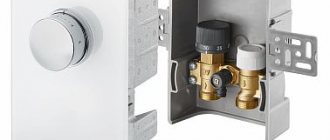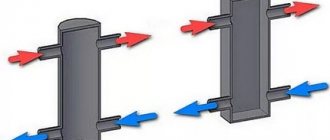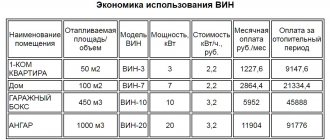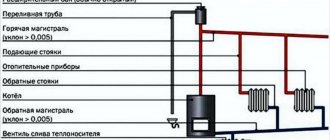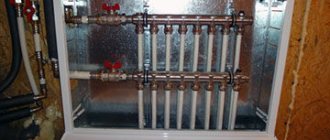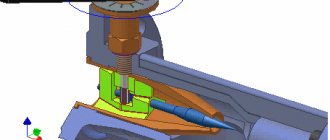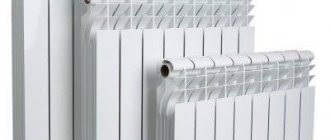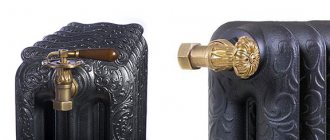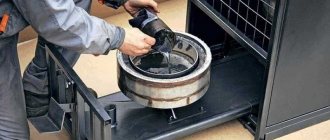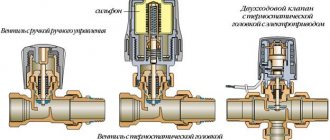Diagrams by type of coolant supply
The radiator will work effectively if the coolant is evenly distributed across all sections.
Warm and cold water have different densities. The heated coolant always tends upward. In the system it is replaced by cold, denser water. This feature is taken into account when supplying coolant to the batteries.
Upper eyeliner
Each radiator has vertical channels connecting the horizontal upper and lower manifold. The presence of these elements allows the coolant to circulate in the device.
With the top connection, mainly only the top of the battery heats up. To prevent such an effect, a jumper is installed after the first rib in the direction of flow of the coolant. Therefore, the heated water first falls into the lower collector.
Then it passes through all sections of the radiator and enters the return pipeline. As a result, the top connection turns into a diagonal way to connect the battery.
If there is no jumper in the radiator, the supply pipe is connected at the top, and the return pipe at the bottom from the opposite end of the battery. This option is called diagonal strapping.
Bottom eyeliner
This is the easiest way to tie. The scheme involves installing the boiler in the basement or on the ground floor. From the heat generating unit, the main pipeline is led to the attic, where the expansion tank is installed. A starting line is laid from the tank, but not lower than 1.5 m to the first radiator.
The supply and return are connected to the batteries at the lowest points on opposite sides. All radiators in the system are connected to pipelines in the same way and installed in series.
When installing a heating circuit with natural circulation, the pipes are laid at an angle. The last battery must be located above the boiler. The height difference between the final radiator and the heat generating unit should not exceed 3 m.
Connection in progress:
- circulation pump;
- bypasses;
- shut-off valves;
- Mayevsky cranes.
Pumping equipment runs on electricity. When it is turned off, circulation of the coolant is possible only in a natural way. Therefore, it is better to lay pipelines at a slope.
From firewood to coal
Steam heating from a stove is most often carried out if your home still has a clay stove structure. This option is somewhat outdated; it includes only one circuit. The pipeline that leaves the furnace must go higher than the one that returns to the heating boiler. Otherwise, normal circulation in the system will not occur. If necessary, you can install a pump for pumping.
Scheme of steam heating from a furnace.
The scheme is very simple: a boiler is connected to the stove to heat water, convectors are connected in series, after which the coolant flows back to the stove. This option is recommended if the area of the house is more than 60 m², and the amount of water required for heating is more than 80 liters. An outlet cannot be installed near the pipe, the only exception being when the total area of the room is more than 40 m². The heating convector should be located near the windows.
The choice of heating pipes is of great importance. If the stove is heated with wood, then the pipes must be metal, since the temperature will be up to 112 ° C, and plastic, even very high quality, may not withstand such heat. If the fuel is coal, then the pipes can be plastic with special thermal insulation.
With such heating, it is not recommended to install a water-heated floor, as this requires an additional volume of water and a double-circuit system, which is strictly prohibited. The maximum water consumption for such a system is 60 liters, and for the floor alone it will take about 40 liters. In a private home, it is recommended to change such a system to a more modern one, and not to build it “from scratch,” since it is planned to soon ban the use of stove steam heating.
You can make a steam heating system at home based on a boiler heated by wood. In some cases, this is quite profitable; modern boilers that run on solid fuel can be used. Using such a scheme allows you to reduce the cost of heating your home by about 4 times. Some boilers can also operate on liquid fuel. There is no need to install a pump here, since dry firewood heats the water enough for it to circulate independently through the heating system. A boiler in a private house is suitable with a power of 12 to 30 kJ; it must be installed in the basement.
Installation of such steam heating can be carried out in several ways. In some cases, it is possible to connect to a water heated floor system for greater efficiency and proper heating of the entire home.
In remote villages, many, after weighing all the pros and cons, prefer stove heating. Autonomy has a lot of advantages, but it’s difficult to heat a house of more than 50 m2 efficiently and evenly using a stove. Unless you install a heat exchanger in it and connect batteries to it. If water circulates as a coolant in such a system, then it will be called water heating, if steam - steam heating.
Sometimes these two types of heating are confused. However, they have their differences, advantages and disadvantages. In addition, steam heating has long been prohibited in residential buildings due to unsafe operation. But it costs much less than water and, in addition, there are protection measures. True, it cannot be said about the ease of installation; on the contrary, in order to install steam heating in a private house, and even from a brick stove, it is necessary to put in a lot of effort and time. But first things first.
Heating radiator connected to the stove
Steam heating in a private house
The complex design of steam boilers, as well as the excessive power of such units, limit their scope of application primarily to the industrial and municipal segment of the heat-generating equipment market.
Moreover, in these sectors, steam generating boilers simply have no competitors. However, some “steam” models can also be introduced into the heating scheme of a private home, increasing its productivity and efficiency.
The steam heating pipeline has a small diameter
Operating principle of a steam boiler
A steam heating boiler is a powerful and productive heat generator that is superior to its “water” counterpart in almost all characteristics.
At the same time, the key to such dominance is the very principle of operation of the unit, which is as follows:
- Water from the tank at the top flows into a collector at the base of the boiler.
- From the collector, water is supplied back to the tank, passing through a tubular heat exchanger built into the firebox.
- A gaseous fraction with a lower density is separated from the liquid superheated in the firebox - steam, “collected” by a receiver built into the upper tank.
- Boiling water mixes with the still cold medium in the tank, increases its temperature and “goes” down to the collector, and then to the heat exchanger.
Simply put: a conventional “portion” of water circulates between the tank and the collector until the energy of the firebox turns all the liquid into steam, which is supplied from the receiver to the boiler pressure pipe.
That is, only the heated coolant goes to the consumer, and the water that has not matured to the state of steam remains in the boiler, increasing the temperature of the condensate “returning” along the return line. As a result, the owner of such equipment can count on a number of beneficial qualities and characteristics.
Steam heating scheme for a private house
Advantages and disadvantages of steam generating equipment
The operation of steam boilers operating on the basis of the operating principle described above guarantees the owner of the heating system the following set of advantages:
- Rapid heating of the serviced space - the gaseous coolant moves through the wiring at high speed, transferring a huge “portion” of energy from the boiler to the batteries.
- Savings on pressure equipment - boiling water creates pressure in the steam space of the boiler, providing a sufficiently strong incentive for coolant circulation. The return of condensate to the water space of the unit is ensured by the force of gravity.
- Saving on fuel - a steam generator uses any type of fuel in its operation: from cheap firewood and gas to expensive electricity and fuel oil. At the same time, the operating scheme ensures the highest possible efficiency of the boiler due to the reuse of water that has not yet boiled.
Possible disadvantages of steam heat generating plants include the following facts:
- High steam pressure in a steam heating boiler, which reduces the overall safety level of the installation. That is, despite the reliability of the design, if handled carelessly, such a boiler can simply explode.
- High coolant temperature, due to which the heating system will have to be assembled using steel pipes capable of withstanding heat above 100 degrees Celsius.
Boiler for steam heating using gas fuel
In addition, it is also necessary to mention the need for frequent repairs of components of the steam generating unit, which are destroyed due to constant contact with hot media - coolant, flue gases, open fire.
Types of steam boilers
- The fire tube installation is an outdated model that involves heating water with the energy of the “exhaust” gases of the furnace moving through tubular air ducts, which are mounted directly into the water space of the boiler. Such units require too frequent repairs and cannot generate more than 360 kW of thermal power and 10 atmospheres of pressure in the wiring. But the main disadvantage of the fire tube option is the tendency to overheat, resulting in the explosion of the equipment, and poor controllability of the steam generation process.
- The water-tube installation is a completely modern model that involves heating the liquid circulating in the tubes of the heat exchanger with the energy of gases burned outside it. Simply put: a heat exchanger made of refractory metal is immersed in the “combustion chamber” of such a boiler, into the internal cavity of which water is poured, boiling under the influence of the heat of the firebox. Such a boiler will not explode due to careless handling. In addition, such a system is configured to maximize the use of energy from burned fuel, which allows water tube boilers to demonstrate the highest possible efficiency.
- The once-through unit is an industrial version of the water-tube model, used as a steam generator both in power plants and in public utilities. This option is distinguished from the previous model by the presence of pressure equipment that pumps water through a heat exchanger with a maximum surface area. Moreover, as the medium moves along the circuit, most of the liquid turns into steam, ready for consumption. Such installations will operate in both steam generating and hot water modes, providing any level of thermal power and any pressure in the distribution.
Steam heating of a private house - recommendations for arranging the system
Such a heat generating installation can only be used if the home meets the following requirements:
- The fire resistance of the main structural elements of the building is at least 75 minutes.
- The presence of window openings in each room.
- Availability of efficient supply and exhaust ventilation of at least one cycle.
- The height of the ceilings in the building is at least 220 centimeters.
- The presence of a boiler room or the ability to place the boiler at a distance of 100 centimeters from the walls and ceiling.
Copper piping is considered very reliable
If your home meets these requirements, then you can proceed to the heating system installation process, taking into account the following recommendations:
- The system wiring is assembled only from metal pipes - steel or copper.
- The optimal wiring diagram is two-pipe or, as an option, manifold. It is better to leave single-pipe wiring for the water heating circuit - it makes too much noise.
- The power of a steam heating boiler is selected according to the classical proportion - square meter = 0.12 kW or cubic meter = 0.041 kW.
- The optimal type of heating battery is a plate convector or bimetallic radiator. But it is better not to use panel batteries and cast iron radiators. The first ones will not withstand the steam pressure. The latter do not demonstrate very high energy efficiency.
- In a small area, a condenser will have to be installed into the return of the system - a steam “thickener”, equipped with a circulation pump. Since a “short” wiring circuit will not be able to provide natural condensation of the coolant. In this case, the energy released by the condenser can be used to indirectly heat the boiler of the hot water supply system.
- As a sealant for threaded joints, you will have to use a heat-resistant material, because the steam temperature reaches 250 degrees Celsius.
The installation diagram of the boiler, batteries and pipelines in this case is not different from the generally accepted version of the “piping” of a hot water boiler.
climanova.ru
What is steam heating?
Steam heating is a system that uses steam as a coolant. How steam heating works in a private house: water boils in a boiler (heat source) and steam is transferred through pipes to heating devices. When moving through pipelines, the coolant condenses and settles on the inner walls of the radiators, giving off almost all of the heat. The batteries heat up themselves and transfer heat to the room.
The condensate formed after the carrier settles returns to the heating source by gravity - if the system is closed or using a pump (in open structures).
Advantages and disadvantages of steam heating
Experts note the following advantages of steam heating:
- Increased productivity. In a private house, you won’t need to install a lot of radiators, and in some cases, pipes without radiators are enough.
- Low inertia. To feel the warmth in the room, 10-12 minutes from the start of heating the boiler are enough.
- Reduced heat loss makes the steam heating system as economical as possible; you don’t have to buy expensive equipment to equip the structure.
- Easy to install. The process of forming a network in a private home is not complicated and can be done with your own hands.
Minuses:
- high temperature of operating devices;
- lack of smooth regulation of room heating temperature;
- restrictions on the choice of material (pipes must be metal only).
It may also be difficult to connect taps to a running system when the elements are heated to 100 C; any touch causes a burn.
To control the heating structure in a private home, experts recommend installing an automatic system that, when the air in the rooms cools down to a certain level, will put the entire system into operation. It is also possible to install automation not on one main branch, but on each (parallel) one, in order to separately start heating a particular room - this is more convenient and economical.
It is precisely because of the threat of accidents that the system is not used in multi-apartment buildings, and in private houses it is installed only under the personal responsibility of the owner.
Characteristics and diagram of the device
The principle of operation is based on the release of heat as a result of the conversion of the coolant, precipitation into condensate, which is removed from the devices and again enters the boiler.
- In a closed system, where the condensate returns to the boiler by gravity under the influence of the difference in temperature and pressure in the heating units. For boilers in such systems, the most important indicator is the temperature and pressure height.
- In an open-loop system, condensate accumulates in a tank, from where it is pumped by a pump or pump to the heating station. When setting up such a scheme, it is necessary to ensure unhindered drainage of condensate into a special tank from the lower heating device.
Based on steam pressure, an open-loop steam heating circuit can be of 4 types:
- subatmospheric;
- vacuum-steam;
- low blood pressure;
- high blood pressure.
The maximum permissible threshold for heating steam is up to 130 C, but for a vacuum-steam, sub-atmospheric pressure system, the ambient temperature is much lower than +100 C. Such steam heating schemes make it possible to change the magnitude of the vacuum (vacuum) and adjust a comfortable temperature regime. The advantage is the absence of complex units when arranging heating. There are enough steam lines (pipes for transporting the medium) and condensate lines (for transferring condensate to tanks) to start a steam boiler and get an efficient home heating system.
Bimetallic material
Bimetallic radiators are made of an alloy of steel and aluminum. The internal surface of the devices is made of steel. The material is resistant to corrosion. The outer walls are made of aluminum. The equipment has high thermal conductivity and durability. The material withstands water hammer well. Radiators are lightweight and easy to install. If the distance between the axes in the section is 500 mm, then the operating power can reach 190 W.
Manufacturers offer the following models of bimetal batteries:
- “Rommer Optima BM 500” – power 500 W;
- “Rifar Supremo 500/90” – the radiator consists of 6 sections; equipment power 121 W; maximum operating pressure 100 bar;
- “Pasotti IPS Elegant” 500/100 – battery consists of 8 sections; 170 W; maximum pressure 35 bar.
The equipment is well suited for steam heating. The only drawback is the high cost of the products, but the material is considered durable. The purchase will be profitable.
Why are radiators poor at heating a room? The technical documentation for each device indicates the technical characteristics: operating temperature, pressure and heat transfer power. When equipping a room, it is necessary to calculate the number of sections in the device. The calculation is performed using the formula: number of sections = S premises * 100 / steam heating radiator power.
Bimetallic radiator
Radiators for steam heating are selected according to the characteristics of the material from which the equipment is made. The power of the device, optimal atmospheric pressure, and operating temperature are taken into account. The design solution of the heaters also matters.
YouTube responded with an error: The request cannot be completed because you have exceeded your quota.
- Related Posts
- Features of steam heating in a private house
- What are the features of Leningradka steam heating?
- How does a low pressure steam heating system work?
- What types of pipes are there for steam heating?
- How to organize steam heating of a garage with your own hands?
- Pros and cons of steam heating without a pump
Air heating
To install an air heating system yourself, you must purchase:
- air purification filters
- generator
- UV filter for air purification
- humidifier
- air duct system
- thermostat
- air ducts
Advantages of air heating:
- The entire heating system is mounted in the wall
- the room is heated evenly
- no noise
- air heating is 20-30% more economical than water heating
- The air heating system must have an air filtration function. At the same time, the air is cleaned of dust and unpleasant odors, and the filter element is changed every six months
- The air during air heating is always sufficiently humidified
- rapid heating of the room
- a special thermostat allows you to vary the temperature in the room from 5 to 35C
Disadvantages of air heating:
- installation of an air heating system can only be done during the construction of a building
- warm air is supplied from under the ceiling, and it must fall down, which is very difficult. Therefore, drafts, albeit warm, are present in rooms with air heating
- As a rule, this type of heating is combined with air conditioning and humidification, which increases the cost of the entire system
- in residential premises such a system is rarely used
Stages of installation of an air heating system:
Stage 1: you need to carefully calculate whether this air heating system can warm up such a room area. If air is supplied at high speed, the system will operate noisily.
Stage 2: an air duct in a wooden house, for example, made of laminated veneer lumber, can be laid in the ceiling. In masonry or concrete houses, air duct dampers must be used. Air ducts are secured using anchors. If the air ducts pass through some section “in vain,” then they must be insulated to avoid heat loss. Air ducts, depending on the type of heat generator, can be flexible, rigid or combined. In addition to the air ducts themselves, it is necessary to purchase anchors, dampers, tie-ins, etc. as part of the kit. The total length of the air duct should not exceed 30 m, otherwise there will be severe heat loss.
Stage 3: round diffusers and rectangular grilles can serve as air ducts in rooms. The latter look aesthetically pleasing, but they reduce the air flow rate. Round diffusers are used on the floor.
Advantages and disadvantages
These qualities can be confirmed by numerous satisfied consumers who at one time settled on this type of system. Note that experts call steam heating extremely promising due to its efficiency, availability and ease of installation.
Obvious advantages of steam heating:
- saving on fuel;
- heating efficiency;
- servicing the system is not difficult;
- the equipment operates for a long time without additional repairs.
DIY steam heating
The installation of steam heating consists of two stages - design and installation itself.
Stage 1. System design
System design
We remind you once again about the peculiarities of using steam as a coolant - the high temperature of the pipeline and radiators, as well as an increased accident rate. When all the pros and cons are weighed, you can begin work. First, a draft of the future system is created.
Boiler
Wood boiler
First, the required power of the heat generator is determined. In this case, the area of the house is taken into account - if it does not exceed 200 m², then a device with a power of 25 kW is sufficient, but if it fluctuates between 200 m² and 300 m², then a minimum of 30 kW will be required. Based on this information, a boiler is selected. The following factors should be considered when purchasing:
- the type of fuel that will be used;
- possibility of heating water for domestic needs.
Heating scheme
Two-wire system with top wiring
Single-wire system with bottom wiring
Diagram of an open heating system
The scheme also needs to be decided in advance. The choice of one option or another depends on:
- boiler location;
- area of the heated room;
- conditions for installation of heating devices;
- the required number of these devices.
In short, this is a rather difficult choice, in which the video below will help.
Pipes
For steam heating, the use of conventional plumbing pipes is unacceptable due to the high temperature of the entire system
For this reason, great attention should be paid to the choice of pipes, even if it is small.
- Copper pipes are characterized by excellent thermal conductivity and high cost. Installation is carried out by soldering.
- The advantage of steel pipes is their resistance to aggressive environments and mechanical stress, the disadvantage is their susceptibility to corrosion. A welding machine is required to install them.
- Galvanized products combine the positive qualities of the previous ones - they do not rust and are relatively inexpensive. The pipes are joined using a threaded connection.
In order to facilitate installation work, at the design stage it is necessary to determine:
- location of radiators;
- pipeline length;
- installation locations for distributors, main line branches, adapters, etc.
Price issue
After drawing up the project, future costs are determined. It is difficult to say how much the equipment of such a system will cost, without reference to heating devices, scope of work and specific conditions. Let us only note that, according to experts, steam heating will in any case be cheaper than conventional water heating.
Stage 2. Installation work
Step 1. First, based on the sketch, an exact wiring diagram is drawn.
Heating wiring diagram
Step 2. Next, radiators are installed. It is recommended to place them under the windows - this will not only heat the glass, but also prevent fogging and, as a result, a shift in the “dew point”.
Connecting a multi-section radiator
Installing a heating radiator
Installing a heating radiator
Radiators are installed next
Step 3. The expansion tank is attached. It must be connected to the pipeline leading from the heat generator to the radiators. Another important point: the tank must be installed at the highest point of the heating system.
Fastening the expansion tank
Fastening the expansion tank
It can be closed or open, with or without overflow.
Step 4. Pipelines are installed. This happens as follows: the pipe is brought to the radiator, cut if necessary, after which the leads and inputs are connected. Then the pipe is connected in the same way from the first radiator to the second, then from the second to the third, etc.
Step 5. The circuit is closed, that is, it is brought to the beginning - the heat generator
It is important that the boiler is equipped with a filter and (if necessary) a circulation pump
Vortex heat generator
Step 6. Next you need to install the boiler itself. Quite often, country houses are adjacent to car garages. The heating device can be installed in one of these garages.
Heating boiler installation
In this case, installing a heat generator is no different from a similar procedure in a residential area. In this case, the fill/drain unit can be installed on any section of the highway. This unit is necessary to drain the coolant at the end of the heating season or before repairing the system.
Step 7. All heating devices are tested. If they are new, then it is advisable to invite a specialist for a test run.
Steam heating boiler in a private house
A steam boiler is an alternative type of heating for private houses and cottages. Water heating of buildings is incorrectly called “steam” - such confusion in names is associated with the principle of heating apartment buildings, where an external coolant under pressure is supplied from a thermal power plant to individual houses and transfers its heat to the internal carrier (water), which circulates in a closed system.
general characteristics
Steam heating in a private home is used much less frequently than other methods of heating rooms. It is economically justified to use a boiler in a country house or country house, when year-round living is not provided, and the main role in heating is played by the speed of heating the premises and the ease of preparation for conservation of the system.
The possibility of installing such equipment in addition to existing equipment, for example, a furnace, is another advantage of using steam as a coolant.
Operating principle
As a result of boiling water in the boiler unit (steam generator), steam is formed, which is supplied to the system of pipelines and radiators. During the condensation process, it gives off heat, providing rapid heating of the air in the room, and then in a liquid state it returns in a closed circle to the boiler. In a private house, this type of heating can be implemented in the form of a single- or double-circuit circuit (heating and hot water for domestic needs).
According to the wiring method, the system can be single-pipe (series connection of all radiators, the pipeline runs horizontally and vertically) or two-pipe (parallel connection of radiators). Return of condensate to the steam generator is possible by gravity (closed circuit) or forcibly using a circulation pump (open circuit).
The home steam heating scheme includes:
- boiler;
- boiler (for a double-circuit system);
- radiators;
- pump;
- expansion tank;
- shut-off and safety valves.
Description of steam heating boiler
The key element of space heating is the steam generator, the design of which includes:
- furnace (fuel combustion chamber);
- evaporator pipes;
- economizer (heat exchanger for heating water using exhaust gases);
- drum (separator for separating the steam-water mixture).
Boiler units can operate on different types of fuel, but it is better for private homes to use a steam domestic boiler with the ability to switch from one type to another (combined).
The efficiency and safety of such space heating depends on a competent approach to choosing a steam generator. The power of the boiler unit must be commensurate with its tasks. For example, to create an optimal microclimate in a house with an area of 60-200 m2, you need to buy a boiler with a capacity of 25 kW. For domestic purposes, it is effective to use water pipe units, which are more modern and reliable.
Self-installation of equipment
The work is carried out in stages, in a certain order:
1. Drawing up a project taking into account all the details and technical solutions (length and number of pipes, type of steam generator and location of its installation, location of radiators, expansion tank and shut-off valves). This document must be approved by state control authorities.
2. Installation of the boiler (done below the level of the radiators to ensure upward movement of steam).
3. Pipe layout and installation of radiators. When laying, a slope of about 5 mm should be set for each meter. Radiators are installed using a threaded connection or welding. In reviews of the steam heating system, experienced users recommend installing taps to eliminate problems when air locks occur and facilitate subsequent operation.
4. The expansion tank is installed 3 meters above the level of the steam generator.
5. The boiler unit must be connected only with metal pipes of the same diameter as the boiler outlets (adapters cannot be used). The heating circuit is closed in the unit, and it is advisable to install a filter and a circulation pump. It is necessary to install a drain unit at the lowest point of the system so that the pipeline can be easily emptied for repair work or preservation of the structure. The necessary sensors must be installed on the boiler unit to monitor the process and ensure safety.
6. Testing of a steam heating system is best carried out in the presence of specialists who can not only perform all procedures in accordance with current norms and standards, but also eliminate any shortcomings and inaccuracies in the installation scheme with their own hands.
Steam heating cost
The price of the heating system will depend on the price of the equipment used, the length of the pipelines, installation and commissioning work.
Estimated cost of services:
| Type of work | Unit change | Cost, rubles |
| Installation and piping of boiler equipment | – | 7 000 – 9 500 |
| Radiator installation | PC | 2 500 – 4 200 |
| Installation of mains and risers | m | 85 – 150 |
| Commissioning | – | 9 000 – 16 000 |
According to reviews, heating with a steam boiler is much cheaper than other types due to the ability of the boiler to operate on any available type of fuel and the low price of instruments and materials.
termogurus.ru
Types of steam heating systems
According to the method of installation, steam heating is distinguished into two types: with a closed and open system. In a closed system, condensate flows into a special receiving pipe, which is connected to the corresponding inlet of the cat. It is laid with a slight slope, so that the condensate moves through the system by gravity.
Schemes of open and closed steam heating systems
In an open system, condensate is collected in a special container. When it is filled, it is fed into the boiler using a pump. In addition to different system designs, different steam boilers are also used - not all of them can operate in closed systems.
In general, there are steam heating systems with pressure close to atmospheric or even lower. Such systems are called vacuum-steam systems. What is so attractive about this setup? Because at low pressure the boiling point of water decreases and the system has a more acceptable temperature. But the difficulty in ensuring tightness - air is constantly sucked in through the connections - has led to the fact that these schemes are practically never encountered.
Steam heating with low pressure is more common. Existing steam boilers for domestic use can create a pressure of no higher than 6 atm (at a pressure of more than 7 atm, use of the equipment requires permission).
Wiring types
According to the type of wiring, steam heating is:
- With top wiring (the steam line is located under the ceiling, pipes go down from it to the radiators, and a condensate line is laid below). This scheme is the easiest to implement, since hot steam moves through one pipe, cooled condensate through another, the system is stable.
- With bottom wiring. The steam line is located at floor level. This scheme is not the best choice, since hot steam moves up through one pipe and condensate moves down, which often leads to water hammer and depressurization of the system.
- With intermediate wiring. The steam line is laid just above the radiators - approximately at the level of the window sills. The system has all the advantages of overhead wiring, except that hot pipes are within reach and there is a high risk of burns.
When laying, the steam pipeline is made with a slight slope (1-2%) in the direction of steam movement, and the condensate pipeline - in the direction of condensate movement.
Boiler selection
Steam boilers can operate on all types of fuel - gas, liquid and solid fuel. In addition to choosing fuel, it is necessary to correctly select the power of the steam boiler. It is determined depending on the area that needs to be heated:
- up to 200 m2 - 25 kW;
- from 200 m2 to 300 m2 - 30 kW;
- from 300 m2 to 600 m2 - 35-60 kW.
In general, the calculation method is standard - 1 kW of power is taken per 10 square meters. This rule is valid for houses with a ceiling height of 2.5-2.7 m. Next comes the choice of a specific model. When purchasing, check for a quality certificate - the equipment is dangerous and must be tested.
Which pipes to use
Only metals can normally withstand temperatures during steam heating. The cheapest option is steel. But welding is required to connect them. It is also possible to use threaded connections. This option is budget-friendly, but short-lived: steel quickly corrodes in a humid environment.
At least copper pipes don't corrode
Galvanized and stainless steel pipes are more durable, but their price is not at all modest. But the connection is threaded. Another option is copper pipes. They can only be soldered, they are expensive, but do not rust. Due to their higher thermal conductivity, they transfer heat even more efficiently. So this heating system will be super efficient, but also very hot.
Types of heating system
In practice, you can find a fairly large number of variations of steam heating. Based on the number of pipes, one and two-pipe types of steam systems are distinguished. In the first case, steam moves continuously through the pipe.
In the first part of its journey, it gives off heat to the batteries and gradually turns into a liquid state. Then it moves like condensate. To avoid obstacles in the path of the coolant, the diameter of the pipe must be large enough.
It happens that the steam partially does not condense and breaks into the condensate line. In order to prevent its penetration into the branch intended for condensate drainage, it is recommended to install condensate drains after each radiator or group of heating devices
A significant disadvantage of a single-pipe system is the difference in heating of radiators. Those located closer to the boiler heat up more. Those further away are smaller. But this difference will be noticeable only in large buildings. In two-pipe systems, steam moves through one pipe, condensate leaves through the other. This way it is possible to make the temperature in all radiators equal.
But at the same time, pipe consumption increases significantly. Like water, steam heating can be single or double circuit. In the first case, the system is used only for space heating, in the second - also for heating water for domestic needs. The heating layout also differs.
Three options are practiced:
- With top wiring. The main steam line is laid above the heating devices, and pipes run from it to the radiators. Even lower, near the floor, a condensate pipeline is laid. The system is the most stable and easiest to implement.
- With bottom wiring. The main line is located below the steam heating devices. As a result, steam moves through the same pipe, which should be slightly larger than usual in diameter, in one direction, and condensate in the opposite direction. This provokes water hammer and depressurization of the structure.
- With mixed wiring. The steam pipe is mounted slightly above the level of the radiators. Everything else is the same as in a system with top wiring, thanks to which it is possible to retain all its advantages. The main disadvantage is the high risk of injury due to easy access to hot pipes.
When arranging a scheme with natural compulsion, you need to remember that the steam pipeline is installed with a slight slope in the direction of steam movement, and the condensate pipeline - condensate.
The slope should be 0.01 - 0.005, i.e. For each linear meter of horizontal branch there should be 1.0 - 0.5 cm of slope. The inclined position of the steam and condensate pipelines will eliminate the noise of steam passing through the pipes and ensure free drainage of condensate.
Steam heating systems are constructed according to one-pipe and two-pipe schemes. Among single-pipe ones, options with horizontal connections to heating devices predominate. In the case of constructing a circuit with vertical connection of devices, it is better to choose a two-pipe option
Based on the level of internal pressure of the system, there are two main types:
- Vacuum. The system is assumed to be completely sealed, inside which a special pump is installed to create a vacuum. As a result, the steam condenses at lower temperatures, which makes such a system relatively safe.
- Atmospheric. The pressure inside the circuit exceeds atmospheric pressure several times. In the event of an accident this is extremely dangerous. In addition, radiators operating in such a system heat up to very high temperatures.
There are many options for arranging steam heating, so everyone can choose the best option for their home, taking into account all the features of the building.
The figure shows a diagram of an open-loop steam heating system
Boilers for steam heating
Types of boilers differ in the type of fuel used. There are boilers for working on natural gas, fuel oil, other liquid and solid fuels, combined and electric units. For example, it is advantageous to install an electric boiler for steam heating in areas with low electricity tariffs at night. The units also differ in the number of pipelines: one- and two-pipe options. Single-pipe designs imply continuous movement of steam through the system.
There are industrial gas boilers on sale, characterized by high efficiency and reduced fuel consumption. They can be used for domestic needs, but only with an increased heated area. Advantages of the equipment: automatic control, compact size, possibility of installation in a room remote from living rooms.
How to calculate boiler power
Before making steam heating, it is necessary to correctly select the power of the heating source - the boiler. This will require the size of the area of all heated rooms.
Standard parameters for the ratio of unit power to room area:
- area 60-200 m2 – power 25 kW;
- in 200-300 m2 - power 25-35 kW;
- in 600-1200 m2 - power 60-100 kW.
Diameters of PP pipes for heating
Polypropylene pipes for plumbing and heating differ in different diameters. This parameter can be called one of the most important when designing a pipeline. The diameter must be selected after hydrodynamic calculations. At the same time, professionals adhere to the goal of selecting the smallest pipe diameter for any section. This indicator must be determined taking into account the operating pressure, as well as the heating circuit.
The diameter of the polypropylene heating pipe is selected based on demand. Thus, if there is a need to equip a large hospital, large sauna or hotel with an engineering system, then, as a rule, pipes with a diameter exceeding 200 mm are used. Only through such products is it possible to create a system that will function correctly and meet the needs of a large number of people.
If there is a need to install heating in a private house from polypropylene pipes, then it is recommended to use products with a smaller diameter. This parameter should vary under the described conditions from 20 to 32 mm. It will be quite easy to lay PP pipes of this diameter yourself, giving them the desired bend. While their capacity will be sufficient for a private developer.
If it is necessary to equip a hot water supply system, reinforced polypropylene heating pipes with a diameter of 20 mm should be used. What about the risers? Here it is advisable to use products whose diameter is equivalent to 25 mm. A central heating system cannot function without pipes 25 mm in diameter. When installing an autonomous heating system, it is necessary to use products with different diameters.
Are you planning to install a heated floor system? Then you should purchase pipes 16 mm in diameter, but no more. Despite existing recommendations, it is necessary to choose the diameter of pipes for installing a heating system, taking into account the individual characteristics of a particular heating branch. If you decide to purchase a PP pipe, then for 4 m you will have to pay 80 rubles. In this case, the product will have a diameter of 20 mm. But a pipe 40 mm in diameter will cost 138 rubles. The length remains the same. A product with a diameter of 63 mm has a price of 345 rubles per 4 m. With a diameter of 90 mm, the buyer will pay 810 rubles.
11 Weird Signs That You're Good in Bed Do you also want to believe that you please your romantic partner in bed? At least you don't want to blush and apologize.
How to look younger: the best haircuts for those over 30, 40, 50, 60 Girls in their 20s don’t worry about the shape and length of their hair. It seems that youth is created for experiments with appearance and daring curls. However, already last.
Top 10 Broke Stars It turns out that sometimes even the biggest fame ends in failure, as is the case with these celebrities.
10 charming celebrity children who look completely different today Time flies, and one day little celebrities become adults who are no longer recognizable. Pretty boys and girls turn into...
Contrary to all stereotypes: a girl with a rare genetic disorder conquers the fashion world. This girl's name is Melanie Gaydos, and she burst into the fashion world quickly, shocking, inspiring and destroying stupid stereotypes.
15 Cancer Symptoms Women Most Often Ignore Many signs of cancer are similar to symptoms of other diseases or conditions, which is why they are often ignored.
Pay attention to your body. If you notice
Peculiarities
This type of heating is a system with a coolant in the form of heated water steam. This is not an innovative invention, since this method was widely used for heating residential premises back in the 19th century. And only then they decided to replace the steam with water. Water and steam heating are different from each other, so do not confuse them.
The replacement was necessary due to the fact that the efficiency of heat transfer using steam is extremely high. This led to excessive heating of the equipment. Its temperature could rise above 100° C. Any contact with heating steam equipment could lead to varying degrees of burns. That is why this option for heating a private house or cottage is quite dangerous.
Today, steam heating in its original form is prohibited from being used in residential and public buildings. However, this restriction does not apply to private property. Therefore, after carefully studying all the features of the steam system, you will be able to install it in your home.
Differences from water heating
Steam heating, in comparison with water heating, has higher heat transfer and ergonomics. Thanks to steam heating, the room heats up 3 times faster than with water.
Also, such a system requires small-sized equipment, so heating is generally cheaper. Steam heating works not only from a wood-burning stove, but from boilers that use waste oil. True, this heating option is not entirely environmentally friendly, so it is used for garages or utility rooms.
Advantages and disadvantages
We can highlight the main advantages thanks to which this type of heating has become widespread:
- low price;
- coolant resistance to low temperatures;
- high efficiency due to convection and radiation;
- small size of the system;
- the ability of steam to penetrate anywhere in the system without reducing the temperature;
- ensuring rapid heating of the room;
- minimal (almost zero) heat loss;
- compatibility with heated floors.
However, the steam system also has certain disadvantages:
- loud noise during operation;
- excessive heating of the equipment, which can lead to burns or accidents;
- inconvenient temperature control;
- relatively short service life due to instability to corrosion.
However, these disadvantages can be corrected. To prevent excessive heating of devices from causing harm to people and animals, it is necessary to fence off radiators and pipes with a special protective screen. Noise during operation can be reduced if you install anti-noise brackets or mount the steam generator in a separate, remote room.
Device
A steam heating device includes several elements. These are: a firebox, a burner, an ash pan, and also a pressure gauge for measuring pressure. The main component of the system is a drum with control and measuring units and a pipeline. Sometimes homemade furnace steam boilers are used for private homes. However, this option is less effective, since in this case the oven is only a steam boiler and it is impossible to cook on it.
Installation work
After drawing up the project and clarifying its features (we will assume that you already know where, what and how it will be located and fastened), you can begin to install the system itself. If necessary, prepare the surface where radiators are installed.
The steam system includes several essential elements. Let's look at each of them in more detail.
The main function of the heating device is to convert water into steam, which subsequently enters the pipeline. The main structural elements of the device are the collectors, drum and pipelines. In addition, there is a container with water, which is called the water space. A steam space is formed above it during operation of the device. They are separated by the so-called evaporation mirror.
Read more: Installing an acrylic bathtub with your own hands
The figure schematically shows one of the types of domestic steam boiler
Additional equipment designed for steam separation can be installed inside the steam space. The operation of the boiler is based on the principle of heat exchange between flue gases, water and steam. There are two types of steam heating devices: fire-tube and water-tube. In the first case, heated gases move inside a pipeline laid inside a container of water.
They give off heat to the liquid, which reaches a boiling point. Water tube varieties work slightly differently. Here, water moves through pipes laid inside the chamber with flue gases. It heats up and boils. Water and steam inside the boiler can move forcefully or naturally. In the first case, a pump is included in the design, in the second, the difference in densities of water and steam is used.
- The prepared liquid is supplied to a reservoir located at the top of the boiler.
- From here the water flows through pipes into the collector.
- The liquid from the collector rises into the upper drum, passing through the heating zone.
- Inside the pipe with water, as a result of heating, steam is formed, which rises.
- Steam, if necessary, is passed through a separator, where it is separated from water. After which it enters the steam line.
- 25 kW for buildings up to 200 sq. m;
- 30 kW for houses with an area of 200 to 300 sq. m;
- 35-60 kW for buildings from 300 to 600 sq. m.
A steam boiler can use a wide variety of fuels. Depending on this, certain changes are made to its design. They touch the combustion chamber. For solid fuel, a grate is installed on which coal, firewood, etc. are placed. Special burners are used for liquid and gaseous fuels. There are also practical combination options.
Among home craftsmen, the installation of steam heating using a stove is especially popular. The photo shows one of the possible options for remodeling the stove
Depending on the heated area, the boiler power is selected. This can be done based on average values:
If more accurate data is needed, use the standard calculation method, where for every 10 sq. meters accounts for 1 kW of equipment power. We must not forget that the formula is used for houses with a ceiling height of 2.7 m or less. For taller buildings, more power must be taken. When choosing a boiler, special attention should be paid to its certification. Any steam heating system is potentially dangerous, so testing the equipment is mandatory.
The coolant temperature in steam systems ranges from 100 to 130C, which is much higher than in liquid systems, where it ranges from 70 to 90C. Therefore, it is strongly not recommended to use similar equipment for arranging systems. First of all, this applies to metal-plastic and polypropylene pipes. The maximum operating temperatures for these materials vary between 90-100C, so their use is strictly prohibited.
An ideal option for installing a steam heating system is copper pipes. They are not subject to corrosion, can withstand high temperatures, but are very expensive
For main pipelines of steam systems, three types of pipes are usually used. The most inexpensive option is steel. They can easily withstand temperatures of 130C, which is more than enough, and are quite durable. However, the condensate formed inside the parts quickly destroys the pipes, since steel is susceptible to corrosion, and the aggressive environment formed by steam only enhances this disadvantage.
Another disadvantage of steel elements is the need for connection by welding, which takes a lot of effort and time. Galvanized steel pipes are much more resistant to corrosion. They also withstand high temperatures well. The threaded method is usually used to connect them, which greatly simplifies the process. The main disadvantage of galvanized pipes is their high cost.
Copper pipes are considered the ideal option. The material can withstand high temperatures, is quite plastic and at the same time durable, and is not subject to corrosion. Soldering is used to connect copper parts. Copper pipelines are very durable and strong, but their cost is very high. Thus, the most acceptable option in terms of quality and price is steel pipes with anti-corrosion coating or galvanized.
The best choice for steam heating is cast iron radiators. They will be able to withstand severe loads caused by the presence of hot steam inside the batteries.
Radiators for steam systems are selected based on strength. It is important that they withstand high temperatures and are resistant to corrosion. Based on this, massive cast iron batteries can be considered the best option, while steel panel batteries are the worst. Given the high efficiency of the system, in some cases it is quite acceptable to use finned steel pipes.
The steam heating system is characterized by an increased emergency hazard, so the presence of monitoring devices is mandatory. The pressure in the system is monitored and, if necessary, normalized. For these purposes, a gearbox is usually used. The device is equipped with a valve through which excess steam is removed from the system. For powerful installations, not one, but several of these valves may be needed.
In practice, you can find a fairly large number of variations of steam heating. Based on the number of pipes, one and two-pipe types of steam systems are distinguished. In the first case, steam moves continuously through the pipe. In the first part of its journey, it gives off heat to the batteries and gradually turns into a liquid state. Then it moves like condensate. To avoid obstacles in the path of the coolant, the diameter of the pipe must be large enough.
It happens that the steam partially does not condense and breaks into the condensate line. In order to prevent its penetration into the branch intended for condensate drainage, it is recommended to install condensate drains after each radiator or group of heating devices
A significant disadvantage of a single-pipe system is the difference in heating of radiators. Those located closer to the boiler heat up more. Those further away are smaller. But this difference will be noticeable only in large buildings. In two-pipe systems, steam moves through one pipe, condensate leaves through the other. This way it is possible to make the temperature in all radiators equal.
https://www.youtube.com/watch?v=c3CaQI2hqdo
But at the same time, pipe consumption increases significantly. Like water, steam heating can be single or double circuit. In the first case, the system is used only for space heating, in the second - also for heating water for domestic needs. The heating layout also differs. Three options are practiced:
- With top wiring. The main steam line is laid above the heating devices, and pipes run from it to the radiators. Even lower, near the floor, a condensate pipeline is laid. The system is the most stable and easiest to implement.
- With bottom wiring. The main line is located below the steam heating devices. As a result, steam moves through the same pipe, which should be slightly larger than usual in diameter, in one direction, and condensate in the opposite direction. This provokes water hammer and depressurization of the structure.
- With mixed wiring. The steam pipe is mounted slightly above the level of the radiators. Everything else is the same as in a system with top wiring, thanks to which it is possible to retain all its advantages. The main disadvantage is the high risk of injury due to easy access to hot pipes.
Read more: How to make an air conditioner with your own hands at home?
When arranging a scheme with natural compulsion, you need to remember that the steam pipeline is installed with a slight slope in the direction of steam movement, and the condensate pipeline - condensate. The slope should be 0.01 - 0.005, i.e. For each linear meter of horizontal branch there should be 1.0 - 0.5 cm of slope. The inclined position of the steam and condensate pipelines will eliminate the noise of steam passing through the pipes and ensure free drainage of condensate.
Steam heating systems are constructed according to one-pipe and two-pipe schemes. Among single-pipe ones, options with horizontal connections to heating devices predominate. In the case of constructing a circuit with vertical connection of devices, it is better to choose a two-pipe option ()
Based on the level of internal pressure of the system, there are two main types:
- Vacuum. The system is assumed to be completely sealed, inside which a special pump is installed to create a vacuum. As a result, the steam condenses at lower temperatures, which makes such a system relatively safe.
- Atmospheric. The pressure inside the circuit exceeds atmospheric pressure several times. In the event of an accident this is extremely dangerous. In addition, radiators operating in such a system heat up to very high temperatures.
There are many options for arranging steam heating, so everyone can choose the best option for their home, taking into account all the features of the building.
The figure shows a diagram of an open-loop steam heating system
To properly make steam heating, you need to start by preparing the project. Its development is a complex task, which is best solved by specialists. There are many things that need to be taken into account in the finished project. First of all, the thermal loads on each of the premises and on the building as a whole are calculated. The steam source is selected, and the mechanism and degree of automation of the system are determined.
Advantages and disadvantages
Steam heating is not the most popular, but it has both positive and negative aspects. Moreover, the advantages are quite significant:
- High heating efficiency. The fact is that the steam in the system does not just heat radiators and pipes to a certain temperature. Due to the large temperature difference, it condenses. And during condensation, 1 liter of steam releases 2300 kJ of heat. Whereas when the same amount of water cools by 50°C, only 100 kJ is released. Therefore, a very small number of radiators are required to heat the room. In some cases, a certain number of pipes is sufficient.
- Since steam heating is a small system, it has low inertia. The room begins to heat up literally a few minutes after the boiler is started.
The disadvantages of steam heating systems are even more impressive:
- The high temperature of the steam leads to heating of all elements of the system to 100°C and above. This leads to the following consequences: very active air circulation in the room, which is uncomfortable and, at times, harmful (if you are allergic to dust);
- the air in the room dries out;
- hot elements of the system are dangerous and must be closed, and the pipes too;
- not all building materials can easily withstand prolonged heating to such temperatures, therefore the choice of finishing materials is very limited (in fact, it is only cement plaster followed by painting with heat-resistant paints).
As you can see, steam heating is not the best choice, although it is quite inexpensive to install.
Steel structures
Currently, the most popular among consumers are steel steam heating batteries. They are lighter, easier to transport and connect to the heating main. They can be tubular, panel or sectional.
Equipment is selected depending on power and design:
- tubular - withstand 15 atm.; temperature more than 100 0C;
- panel - 9 atm., temperature up to 100 0C;
- sectional - installed if the steam in the main is under a pressure of 6 atm, its temperature is up to 100 0C.
Experts warn that steel batteries do not withstand water hammer well. With steam heating, structures are purchased that can withstand greater pressure in the line. Another disadvantage of the equipment is that steel quickly gives off heat and cools down in a short time.
When the heating is turned off, the temperature in the room will immediately drop. The following models are offered on the market: “Lemax Premium”, panel; "PURMO", from Finnish, made in Germany.
Principle of operation
The heat source can be a stove or boiler, where the water heats up to 100° C and begins to evaporate. The steam then flows through the pipes into the batteries and cools, forming condensation. The resulting water flows through the return pipe into the heat exchanger.
Steam boiler
When choosing a boiler as a water heater, you should take into account its performance, which depends on the area of the room. In other words, the larger the heated area, the more powerful the boiler should be.
In those houses that already have steam heating installed, a solid fuel boiler is most often used. A gas heat generator has the highest efficiency, but using an electric boiler to heat a private house or other premises is not economically profitable due to high energy costs.

